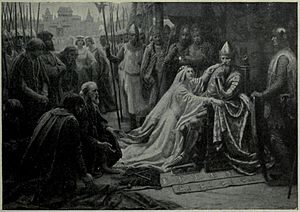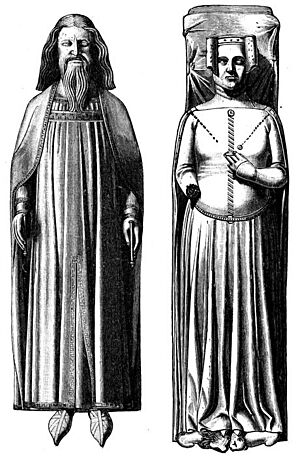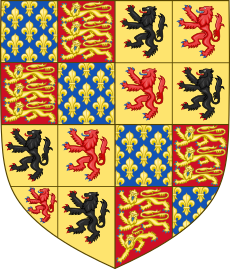Philippa of Hainault facts for kids
Quick facts for kids Philippa of Hainault |
|
|---|---|
| Queen Consort of England | |
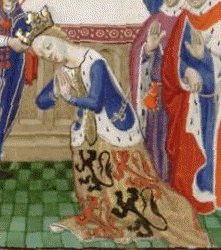
Philippa's coronation
|
|
| Tenure | 24 January 1328 – 15 August 1369 |
| Coronation | 18 February 1330 |
| Born | 1310–1315 Valenciennes, County of Hainaut, Holy Roman Empire |
| Died | 15 August 1369 (aged c. 56) Windsor Castle, Kingdom of England |
| Burial | 9 January 1370 Westminster Abbey |
| Spouse | |
| Issue more... |
|
| House | Avesnes |
| Father | William I, Count of Hainault |
| Mother | Joan of Valois |
Philippa of Hainault was an important Queen of England. She was married to King Edward III and was his trusted adviser. She even ruled England for a short time in 1346 when the King was away fighting in the Hundred Years' War.
Philippa was the daughter of Count William of Hainaut and Joan of Valois. She married Edward in 1328, after he became King of England. Philippa helped King Edward improve England's trade. She was also part of the successful Battle of Neville's Cross. She often joined her husband on trips to Scotland and France. People in England loved her because she was kind. For example, in 1347, she convinced the King to save the lives of the Burghers of Calais. Her popularity helped keep England peaceful during their long reign.
Contents
Early Life and Royal Marriage
Philippa was born in Valenciennes, in the Low Countries, around 1310 or 1315. She was one of eight children. Her parents were William I, Count of Hainaut and Joan of Valois, Countess of Hainaut. Her mother, Joan, was the granddaughter of King Philip III of France.
King Edward II of England wanted to make an alliance with Flanders. He sent a bishop to Hainaut to meet Count William's daughters. The bishop was looking for a suitable bride for young Prince Edward.
Philippa grew up in a region that was becoming a big trading center. This meant she learned a lot about money and negotiations.
In 1326, Isabella of France, the Queen of England, visited Hainaut. She wanted Count William's help to remove her husband, Edward II, from the throne. Prince Edward came with his mother. While there, Isabella arranged for Philippa, who was 13, to marry Prince Edward. This marriage was part of the deal for Count William's help.
Because Philippa and Edward were second cousins, they needed special permission from the Pope. Pope John XXII sent this permission in September 1327. Philippa arrived in England in December, greeted by a big welcome in London.
Becoming Queen of England
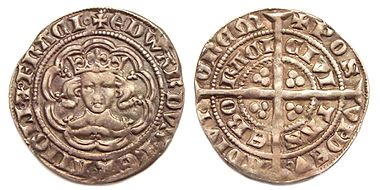
First Years as Queen
Philippa officially married Edward at York Minster on January 24, 1328. This was eleven months after Edward became King of England. At first, Edward's mother, Queen Isabella, and her partner, Roger Mortimer, were the real rulers.
After their wedding, Philippa and Edward lived at Woodstock Palace. Unlike some queens before her, Philippa did not upset the English people. She did not bring many foreign people to the English court.
Philippa supported the writer Jean Froissart. He described her as "The most gentle Queen, most liberal, and most courteous that ever was Queen in her days."
Philippa's coronation was delayed for two years. She was crowned queen on February 18, 1330, at Westminster Abbey. She was almost five months pregnant at the time. Her first son, Edward, the Black Prince, was born that June.
In October 1330, King Edward took full control of the kingdom. He ordered the arrest of Isabella's partner, Roger Mortimer, who was later executed. Queen Isabella was sent to Castle Rising, but later got back some of her freedom.
Philippa's Influence and Actions
Philippa was a great queen. She worked hard for the country and balanced her royal duties with her family life. People loved and respected her. She had a very successful marriage with Edward.
The Hundred Years' War cost a lot of money. Philippa wisely advised the King to focus on England's trade to help pay for the war. She helped start the textile industry in Norwich. She encouraged weavers from Flanders to move there. She also promoted coal mining in Tynedale.
In 1346, Philippa was chosen to rule England as regent. This happened while her husband was away fighting in the Hundred Years' War.
Military Campaigns and Compassion
As regent in 1346, Philippa faced a Scottish invasion. She gathered the English army and fought the Scots at the Battle of Neville's Cross near Durham. She rode among the soldiers before the battle, encouraging them. The English won, and the Scottish King David II was captured. He was held prisoner for eleven years.
Philippa also went with her husband on trips to Scotland and Europe during the early parts of the Hundred Years' War. She was known for her kind and caring nature. She is especially remembered for convincing her husband to spare the lives of the Burghers of Calais. The King had planned to execute them after his successful siege of the town.
Death and Legacy
Queen Philippa died on August 15, 1369, at Windsor Castle. She had an illness similar to swelling. Her state funeral was held on January 9, 1370. She was buried at Westminster Abbey. Her tomb was placed near her husband's grandparents, Edward I and Eleanor of Castile. Eight years later, Edward III died and was buried next to Philippa. Their marriage of forty years was considered a happy one.
The Queen's College, Oxford was founded in her honor by her chaplain, Robert de Eglesfield.
Royal Children
Philippa and Edward had thirteen children. Five of their sons lived to be adults. Sadly, three of their children died from the Black Death in 1348. The many children and grandchildren of Philippa and Edward would later cause the long and bloody Wars of the Roses in the 15th century.
| Name | Birth | Death | Notes |
|---|---|---|---|
| Edward, the Black Prince | 15 June 1330 Woodstock Palace, Oxfordshire |
8 June 1376 | Married his cousin Joan of Kent. Had issue (King Richard II). |
| Isabella | 16 June 1332 Woodstock Palace, Oxfordshire |
April 1379 or 17 June/5 October 1382 | Married Enguerrand VII de Coucy. Had issue. |
| Joan | 19 December 1333 or 28 January 1334 Tower of London |
1 July 1348 | Was supposed to marry King Pedro of Castile, but died of the plague before the wedding. |
| William of Hatfield | December 1336 Hatfield, South Yorkshire |
Died shortly after birth. | Buried at York Minster. |
| Lionel, 1st Duke of Clarence | 29 November 1338 Antwerp |
7 October 1368 | Married (1) Elizabeth de Burgh, 4th Countess of Ulster. Married (2) Violante Visconti. Had issue. |
| John, 1st Duke of Lancaster | 6 March 1340 Ghent |
3 February 1399 | Married (1) Blanche of Lancaster. Married (2) Infanta Constance of Castile. Married (3) Katherine Swynford. Had issue (Henry IV of England and the Dukes of Beaufort). |
| Edmund of Langley, 1st Duke of York | 5 June 1341 Kings Langley, Hertfordshire |
1 August 1402 | Married (1) Infanta Isabella of Castile and (2) Joan Holland. Had issue. |
| Blanche |
Tower of London |
Died shortly after birth. Buried at Westminster Abbey. | |
| Mary | 10 October 1344 Bishop's Waltham, Hampshire |
September 1361 | Married John IV, Duke of Brittany. No issue. |
| Margaret | 20 July 1346 Windsor |
1 October/25 December 1361 | Married John Hastings, 2nd Earl of Pembroke. No issue. |
| Thomas | Summer 1347 Windsor | September 1348 | Died in infancy of the plague. Buried at King's Langley Church. |
| William of Windsor | before 24 June 1348 Windsor |
before 5 Sep 1348 | Died in infancy. Buried at Westminster Abbey. |
| Thomas, 1st Duke of Gloucester | 7 January 1355 Woodstock Palace, Oxfordshire |
8/9 September 1397 | Married Eleanor de Bohun. Had issue. |
See also
 In Spanish: Felipa de Henao para niños
In Spanish: Felipa de Henao para niños
- Counts of Hainaut family tree
- Counts of Holland family tree
| English royalty | ||
|---|---|---|
| Vacant
Title last held by
Isabella of France |
Queen consort of England 24 January 1328 – 15 August 1369 |
Vacant
Title next held by
Anne of Bohemia |



